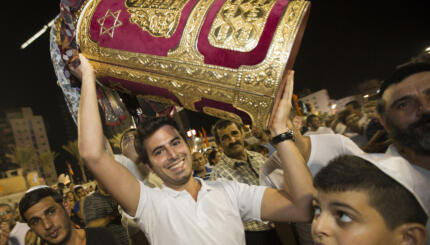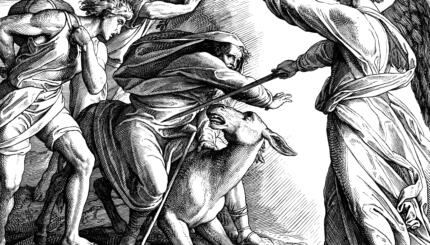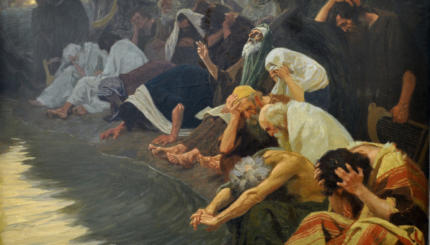Commentary on Parashat Beha'alotcha, Numbers 8:1 - 12:16
Parashat Beha’alotcha is overflowing with complex ritual and detail: the lighting of the lamps; the purification and consecration of the Levites; the elaboration of the Passover sacrifice; the carefully choreographed journey through the wilderness; the mutiny of meat, manna, and quail precipitating a plague for those who were led by their appetites; the challenge of Moses’ siblings to his leadership; and finally, the sudden onset of his sister Miriam’s disease. Yet amidst these richly detailed stories, we find one contrasting, stark, parsimonious prayer: ”El na r’fa na lah” (“O God, pray heal her!”).
Five words — 11 Hebrew letters — are all that Moses speaks (Numbers 12:13). Except for God’s name, each word ends in a vowel, as if each word were an unending cry. It is as if each word is punctuated with an exclamation point, the brevity of the syllables giving voice to the tortured helplessness of the supplicant: “God! Please! Heal! Please! Her!”
In the midst of catastrophe, the verb of consequence — the bull’s-eye of the prayer — is the central plea: Heal! Indeed, in Hebrew the prayer is nearly a palindrome — reading the same forwards as it does backwards — homing in with laser precision on that most urgent desire: Heal!
A Plea from Someone Trying to Help
This prayer has few words but much resonance. It is a primal cry, capturing fear, powerlessness, and incomprehensibility in the face of sudden illness, accident, or injury. It is not the entreaty of the one beset by the catastrophe, but rather that of the witness, the powerless onlooker, the potential caregiver absorbing the shock, the one who is overwhelmed and stymied about how to help.
When illness, accident, or injury comes to those we love, it is up to us — those who are comparatively healthy and able — not only to beseech but also to provide hope and healing. For the caregiver, there is time only for truncated and hurried prayer, time only for stolen moments of naked cries and yearnings of hope. For the caregiver shouldering the burdens of action — making the loved one comfortable, researching treatment, running interference with physicians, reporting news, calming fears–prayer is a blessed moment of calm in an otherwise turbulent time.
READ: Mi Sheberakh, The Traditional Jewish Prayer of Healing
When one whom we love is in danger, not only our loved one but also we ourselves face darkness. According to Jewish tradition, the first person who prayed in darkness was young Jacob, on the eve of his exile from home. The Midrash describes the confluence of physical and metaphorical darkness this way: “In order to speak to Jacob in private, God caused the sun to go down-like a king who calls for the light to be extinguished, as he wishes to speak to his friend in private” (B’reishit Rabbah 68:10). So, too, the prayer of the caregiver is private, conspiratorial, hidden from the one who is the object of supplication, yet revealed to the One who can respond. We want to protect the one who is suffering from the compounded weight of the caregiver’s distress.
But in the darkness, it is safe to give voice to our fear of dreadful scenarios and of the unknown. In the darkness, it is a relief to relinquish the weight of trying to hold up another’s spirits, and to acknowledge that someone with far more power than we possess is the ultimate caregiver. In the darkness, it is possible to renew courage, to find new paths, to discover the equanimity essential to living with the terror of catastrophe.
Danger and Opportunity
Medical sociologist Alexandra Dundas Todd begins Double Vision, a memoir of her son’s treatment and recovery from brain cancer, with this reflection:
The Chinese word for crisis consists of two characters: danger and opportunity. When my son, Drew, a senior in college, was diagnosed with a rare form of cancer bordering his brain, the danger was clear; the opportunity was less apparent. Danger flashed through our lives daily, while opportunities lay waiting in murky waters, to emerge only tentatively.
Family closeness, the ability to savor each moment, to find strength and courage where we didn’t know they existed, to discover new methods of treatment that complemented all the surgeries and radiation and eased both body and mind, all contributed to making the unbearable bearable, turning an assault into a challenge. (Double Vision: An East- West Collaboration for Coping with Cancer, 1994, p. xiii)
It does, indeed, take “double vision” to see both blessing and curse, to picture opportunity amidst danger. Courage grows through hope, through the willingness to look for unknown possibilities and to grasp them, through refusing to see only danger in darkness when its counterpart, opportunity, may be waiting in the shadows. The prayer of the caregiver, the cry of the distraught parent, the reassuring whisper of the loving spouse, can help to wrest some measure of opportunity out of danger.
El na rfa na la. In its simplicity and raw clarity, this prayer of healing recognizes that more than double vision, the vision of the Divine is immeasurable, and the capacity of the Healer is limitless. In response to Moses’ prayer, God reveals the duration of Miriam’s exile to the wilderness of disease. Her fortunate loved ones have only to wait out a time of disequilibrium and uncertainty; they have received sacred reassurance that all will be well. Yet in anticipating her return, the Torah conveys a truth well known to the loved ones of someone contending with affliction and crisis — v’haam lo nasa ad heasef Miryam (“And the people did not march on until Miriam was readmitted,” Numbers 12:15).
Life does not go on with any sense of normalcy or progression while one whom we love is endangered; the caregiver’s attention and effort revolves around the one who is stricken. Time and space are altered. The yearning for healing expands to fill both.
Our present rituals may not be as formulaic as those described in B’ha’alotkha; our contemporary prayers of healing may have become longer and more specific; our modern understanding of treatment may be more nuanced and comprehensive; but Moses’ wisdom abides. The essence of what we seek is still found in his direct and eternal prayer. El na rfa na la: God! Please! Heal! Please! Her!
Reprinted with permission from The Torah: A Women’s Commentary, edited by Tamara Cohn Eskenazi and Andrea L. Weiss (New York: URJ Press and Women of Reform Judaism, 2008).
Torah
Pronunced: TORE-uh, Origin: Hebrew, the Five Books of Moses.


